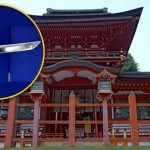Pompeii is a city frozen in time. Thanks to a unique yet catastrophic natural disaster, the ancient Roman city was simultaneously destroyed and well-preserved in 79 AD. Archaeologists, historians, and researchers have been enticed by Pompeii ever since its magnificent ruins were discovered.
Even though archaeologists have been excavating the ruins of Pompeii for decades, the fascinating city continues to reveal glimpses of the grandeur and luxury that once permeated the doomed city. A recently unearthed banquet hall is a prime example of this.
Pompeii Was a Wealthy and Prosperous City
Pompeii was one of the crowning jewels of the Roman Empire in its heyday. A bustling port city in the Bay of Naples, it was a center for trade, commerce, art, and culture. Its citizens benefited from the wealth pouring into the city.
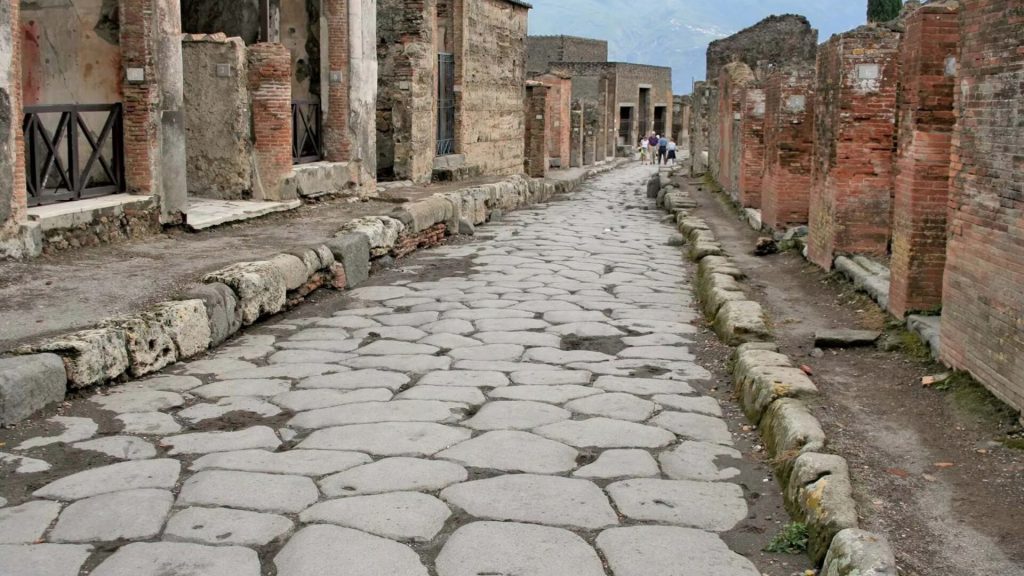
As an outward show of the city’s wealth and prosperity, Pompeii boasts elegant public buildings, sidewalks made of intricate mosaic tiles, a grand amphitheater, ornate temples, and sophisticated urban infrastructure. Numerous posh villas were constructed by the city’s prominent residents, each with lavish frescoes, paintings, statues, and art.
Oblivious to Impending Disaster
The people of Pompeii were busy enjoying the good life in the early decades of the new millennium. But Mount Vesuvius, a soaring peak that formed a picturesque backdrop to the city, was slowly waking from a long slumber. Some minor tremors and puffs of smoke from its summit didn’t seem to worry most residents.

On August 24, 79 AD, Mount Vesuvius erupted with devastating force. Superheated, toxic gas rapidly descended on the people of Pompeii, killing them in their tracks. Layers of pumice and volcanic ash covered the dead, along with the city, preserving it for nearly two millennia.
Pompeii Sees the Light of Day Once Again
In 1748, construction workers were paving the way for the building of a summer palace for Charles III, the King of Naples, when they made a monumental discovery … the ancient ruins of Pompeii. Excavation work began soon afterwards, but much of the initial focus was on treasure hunting, rather than preserving the site for its historic value.

Arguably, the discovery that made Pompeii a household name was the human remains. Researchers were curious about the many hollowed volcanic rocks found at Pompeii. When one of them filled the cavity with plaster of Paris, an amazing and highly detailed mold of a person was revealed. The volcanic eruption covered the bodies of the dead and dying, creating perfect molds.
Continued Work at the Site
Pompeii remains an active archaeological site and excavation work there has been ongoing for several decades. According to estimates, at least one-third of the city is still buried under the volcanic ash.
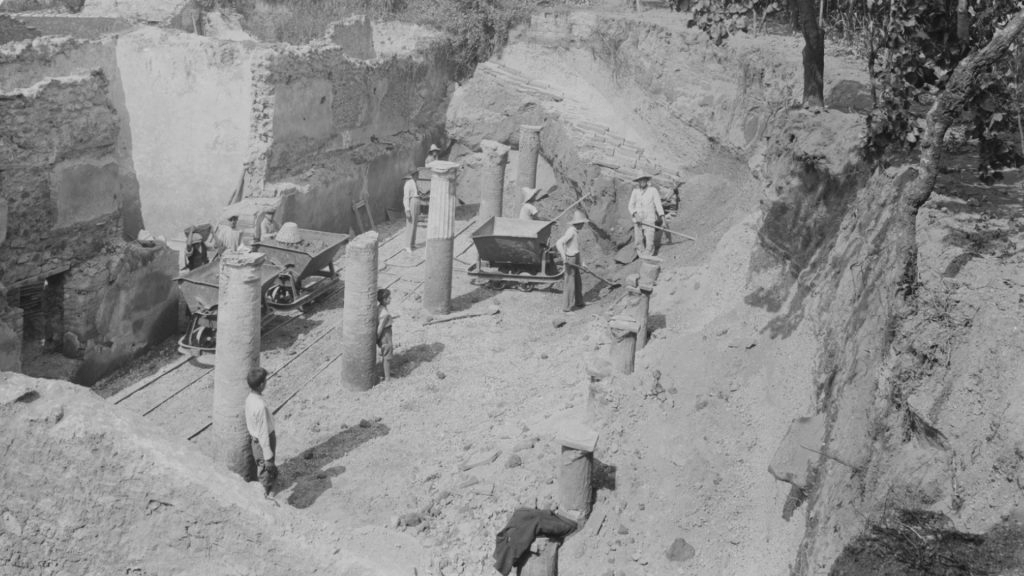
Just when we might think there is nothing left to discover in the ruins, archaeologists announce another impressive find. The most recent discovery – what archaeologists call a “spectacular banquet room – was the result of years of work at the biggest archaeological dig at Pompeii in a generation.
Two Connected Houses
The banquet hall the archaeology team found is located in one of two connected houses. The other house features a bakery. But it is the banquet room that is the most awe-inspiring.
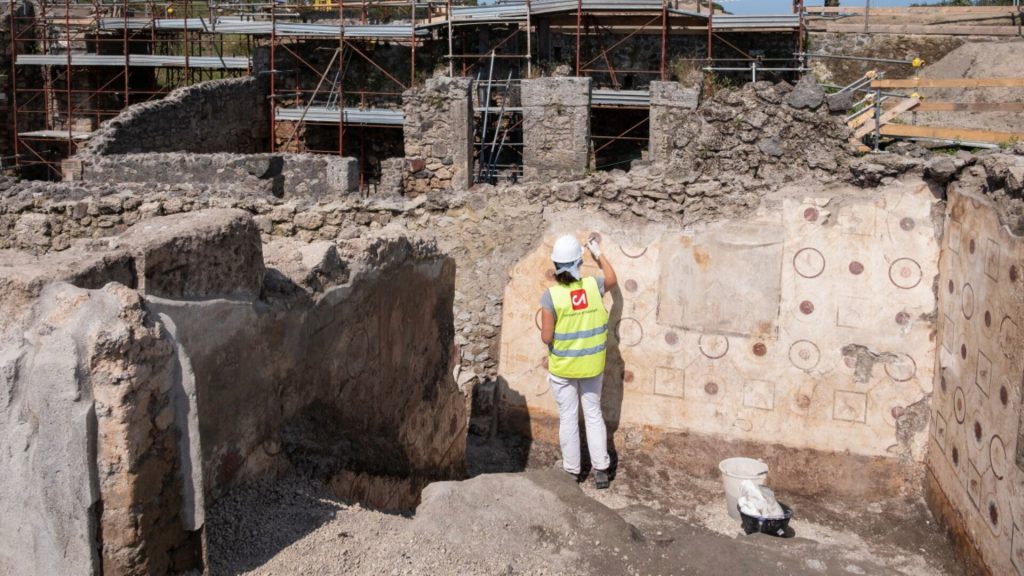
The floor of the hall is almost entirely intact and was composed of small, white mosaic tiles. In fact, there are an estimated one million individual tiles in the banquet hall alone. The wall décor in the banquet hall has caused a buzz in the archaeology world.
“The Walls Were Painted Black”
According to Gabriel Zuchtriegel, who serves as the director of Pompeii’s Archaeological Park, “The walls were painted black to prevent the smoke from the oil lamps being seen on the walls.”

The black walls would have also created a unique effect that mesmerized patrons at the lavish banquets held there. Zuchtriegel explained, “People would meet to dine after sunset. The flickering light of the lamps had the effect of making the images appear to move, especially after a few glasses of good Campanian wine.”
Scenes from Mythology
The well-preserved frescoes adorning the walls of the banquet hall showed detailed scenes from Roman mythology, which was a common theme in the art of the day. The hall, in fact, featured aspects of the Trojan War, including images of Paris and Helen, as well as Apollo and Cassandra.
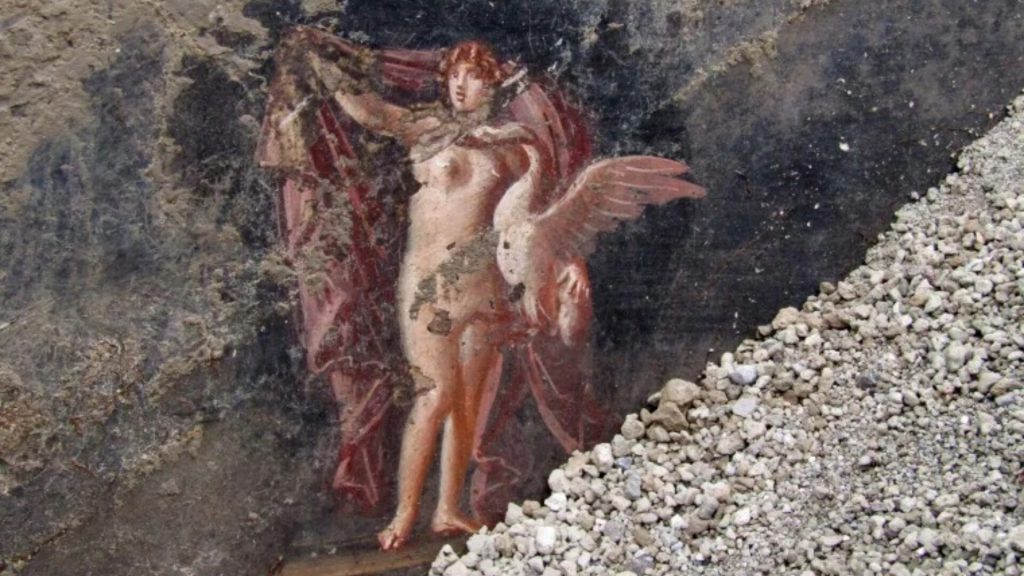
The level of artistry and the quality of the materials used have made these frescoes among the most stunning ones ever found in the ruins of Pompeii. Their discovery is proof that there are more treasured finds to be made at Pompeii.
The Mythology of the Trojan War
The people of Pompeii were enthralled by the romantic and heroic stories from mythology. Stories of the Trojan War, which was detailed in Homer’s Iliad, checked all the boxes for them. It has a beautiful princess, brave warriors, star-crossed lovers, and an epic ploy to bring down the city of Troy from within.
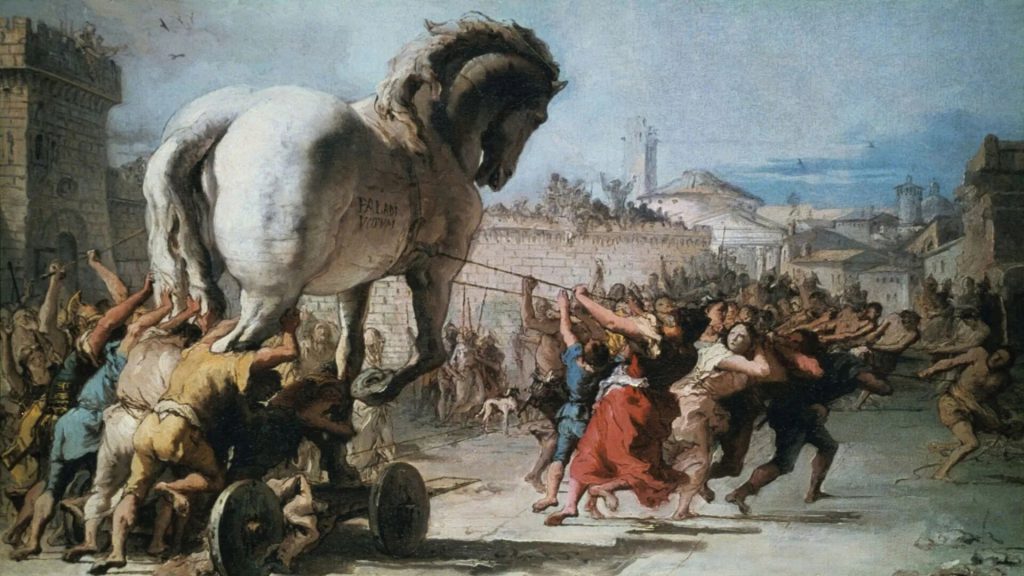
The Trojan War, according to legend, began when Paris, a prince of Troy, kidnapped the beautiful Helen, the wife of Sparta’s king, igniting a fierce war. Even the gods got involved. The downfall of Troy famously occurred when the Greeks gifted the city with a giant, wooden horse as a peace offering. Concealed inside were Greek warriors who emerged after the Trojan Horse was taken inside the city gates to defeat the soldiers of Troy.
Apollo and Cassandra
Another set of would-be lovers, Apollo and Cassandra, are also featured in the banquet hall’s frescoes. As the story goes, Cassandra was the daughter of the king and queen of Troy. The god Apollo took a liking to Cassandra and gave her the gift of prophecy. But Cassandra refused Apollo’s advances.

Enraged, the god added a caveat to Cassandra’s gift of prophecy. She would still be able to see the future, but no one would believe her prophecies. She foresaw the ruse of the Trojan horse, but her warnings were ignored.
A Conversation Starter
Several of the frescoes in the banquet hall show the lovers Paris and Helen, along with the ill-fated Cassandra and the spiteful Apollo. In one fresco, Apollo, who was, among other things, the Greek god of music, plays a lyre in his attempt to seduce Cassandra.

Zuchtriegel explained, “The mythical couples provided ideas for conversations about the past, and life, only seemingly of a merely romantic nature.”
Themes of Fate
According to Zuchtriegel, the frescoes on the walls of the banquet hall all revolve around themes of fate and how individuals are powerless to intervene against fate. He explained that, at first glance, the paintings may seem to be focused on romance, but “in reality, they refer to the relationship between the individual and fate.”
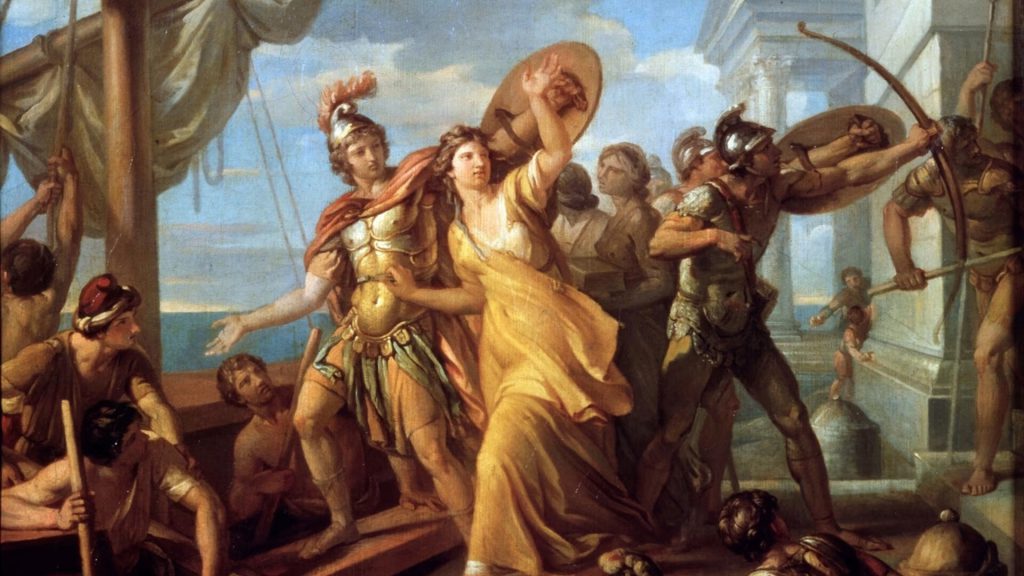
He continued, “Cassandra who can see the future, but no one believes her, Apollo who sides with the Trojans against the Greek invaders, but being a god, cannot ensure victory, Helen and Paris who, despite their politically incorrect love affair, are the cause of the war, or perhaps merely a pretext.”
A “Refined Setting”
According to several experts on ancient Pompeii, the banquet hall represents a “refined setting for entertaining during convivial moments.” The hall was spacious enough for a large gathering. It measures nearly 50 feet long and is about 19 and a half feet wide.
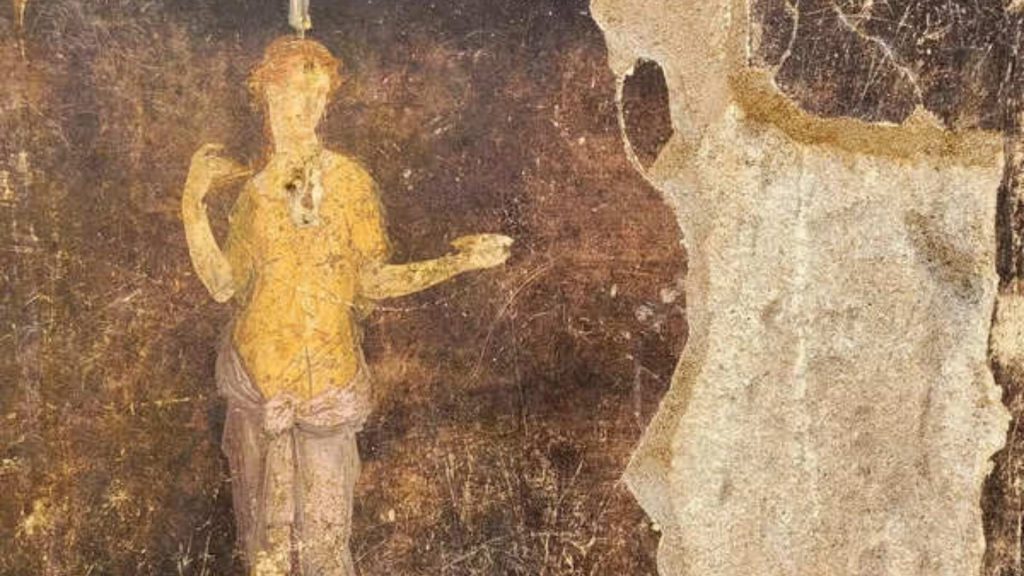
A courtyard was built adjacent to the hall and doorways opened between the two spaces. Archaeologists even discovered an arched staircase leading from the banquet hall to an upper floor. The staircase was not decorated, and a pile of building materials was found near it, leading some to speculate that it was not yet complete.
Part of a Larger Excavation Project
The archaeology work that uncovered this banquet hall is part of a larger, more encompassing project underway at the Pompeii Archaeology Park. The goal of this project is to identify and secure the perimeter between the parts of the city that have been excavated and the areas that are still buried.
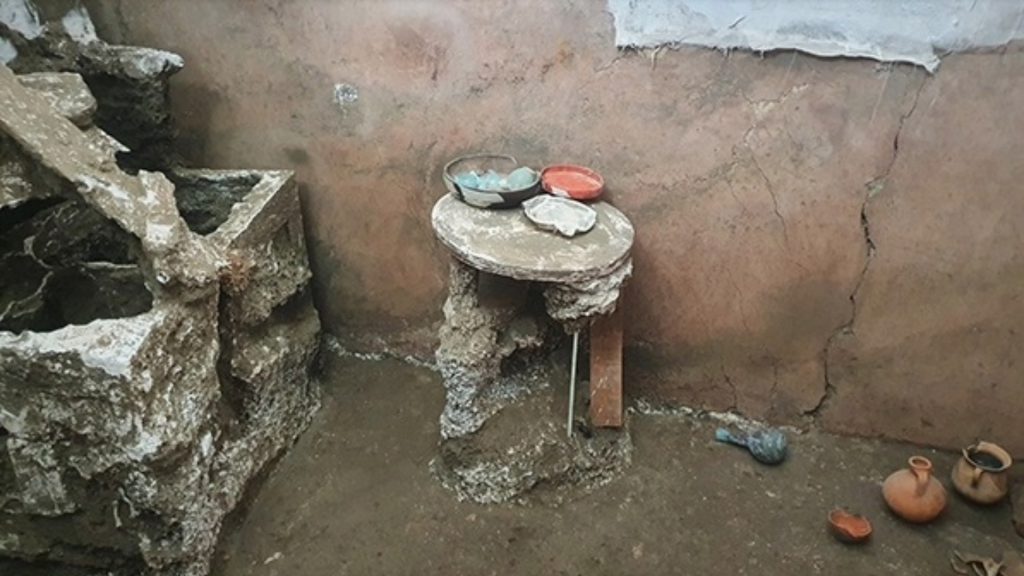
According to a press release, the goal of the project is to “improve the hydrogeological layout to ensure the effective and sustainable preservation of Pompeii’s extensive heritage, comprising over 13,000 rooms across 1,070 residential units.”
Work Is Ongoing at the Two Interconnected Houses
Although the lavish banquet hall is getting most of the public’s attention, the excavation work at the two interconnected houses have uncovered a bakery and a laundry facility. Both dwellings also include beautifully decorated living spaces.

Gennaro Sangiuliano, Italy’s Minister of Culture, stated, “Pompeii is truly a treasure chest that never ceases to surprise us and arouse amazement because, every time we dig, we find something beautiful and significant.”


